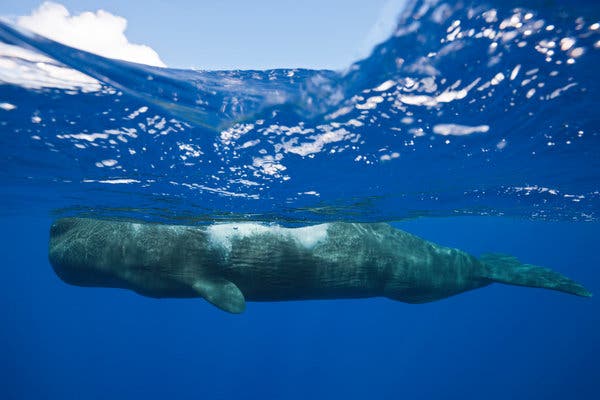Every so often, a fatberg-esque blob of material called ambergris washes up on a beach.
These lumps, used to make perfume, can be worth thousands of dollars in countries where it is legal to collect them. Historically, hunters have trained dogs and even camels to sniff out ambergris.
Where it comes from has been less clear. Modern scientists knew that ambergris could be found within the bodies of sperm whales, but they weren’t sure about those pieces of jetsam found by beachcombers. But in a study published Wednesday in Biology Letters, researchers have extracted sperm whale DNA from washed-up ambergris, which is especially impressive because the studied samples floated adrift for years, aging under salt, sea and sun. The research could contribute a new understanding about the enigmatic substance and the endangered creatures that make it.
“The discovery that ambergris yields such good DNA preservation opens up new opportunities for studying both the use of this precious raw material and whale biology,” said James Barret, an archaeologist at the University of Cambridge who did not participate in the research.
Fresh ambergris smells fecal, musty. But once it ages, its scent is compared with fine tobacco, or the wood in an old church. The mother of the Abbasid Caliph Al-Muqtadir would melt it in oil; Catherine de Medici wore it in scented gloves; and ambergris has anointed English monarchs since 1626, including Queen Elizabeth II.
But where did it come from? That was one of the medieval world’s grossest natural mysteries. Marco Polo’s travelogue said it had something to do with whales. That hunch was confirmed by whalers in New England in the 1700s poking around with spades in the rectums of dead sperm whales.
But since whale populations were decimated, much remains unknown about ambergris, and especially the origin of jetsam ambergris. Its chemical composition differs from ambergris that can no longer be dug out of protected sperm whales.
Ruairidh Macleod, an undergraduate biology student also at Cambridge, led the research. Steven Rowland, a chemist who has collected and analyzed jetsam ambergris, including chunks that may have been at sea for over a thousand years, provided the samples, which were picked up on beaches in Sri Lanka and New Zealand.
The team also turned for assistance to the lab in Copenhagen that recently recovered DNA from a piece of ancient chewing gum.
“Suddenly you’ve got these new techniques available and you take them and apply them to a new — well, old — mysterious substance,” Mr. Macleod said. His team is now hoping to track down more samples of the coveted material for scientific use.
While the research helps confirm that sperm whales, and possibly related species, too, are the source of the ambergris found along the world’s coasts, biologists still don’t know how this fancy fragrance really forms. When sperm whales were still being slaughtered, whalers found that only about one in a hundred yielded ambergris.
One leading theory, advanced in 2006, casts ambergris as what could generously be called a rectal pearl: Formed from layers of excrement that accumulated on an indigestible clump of squid beaks and worm cuticles. Mr. Macleod’s team, though, believes gut bacteria might play a bigger role in making it, a subject for additional study.
The long life span of ambergris and its potential to preserve DNA from long-dead whales could also help scientists estimate populations of sperm whales far before they were pushed to the brink of extinction. The genetic diversity of living sperm whales already suggests the species dwindled during past episodes of climate change, says Alana Alexander, who studies cetacean DNA at the University of Otago in New Zealand. But having samples from before the whaling era would help refine historical population estimates.
DNA might also be used to help prevent theft or illicit collection in places like Australia or the United States, where the substance is illegal under the Endangered Species Act.
Dr. Alexander’s only quibble is the current study’s sample size of ambergris, which she said is to be expected. “It’s certainly not within the average researcher’s project budget to pay wholesale price for it!”















